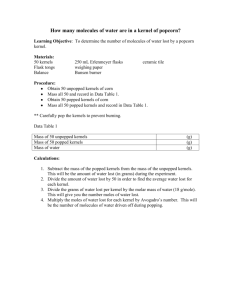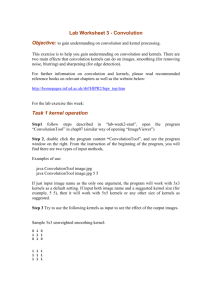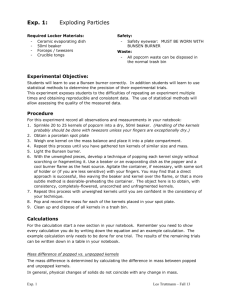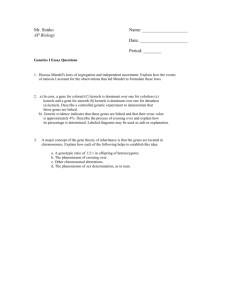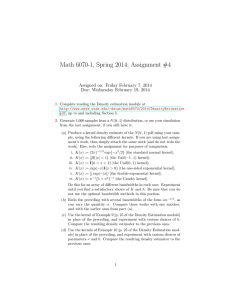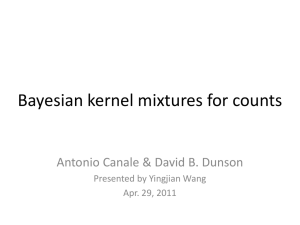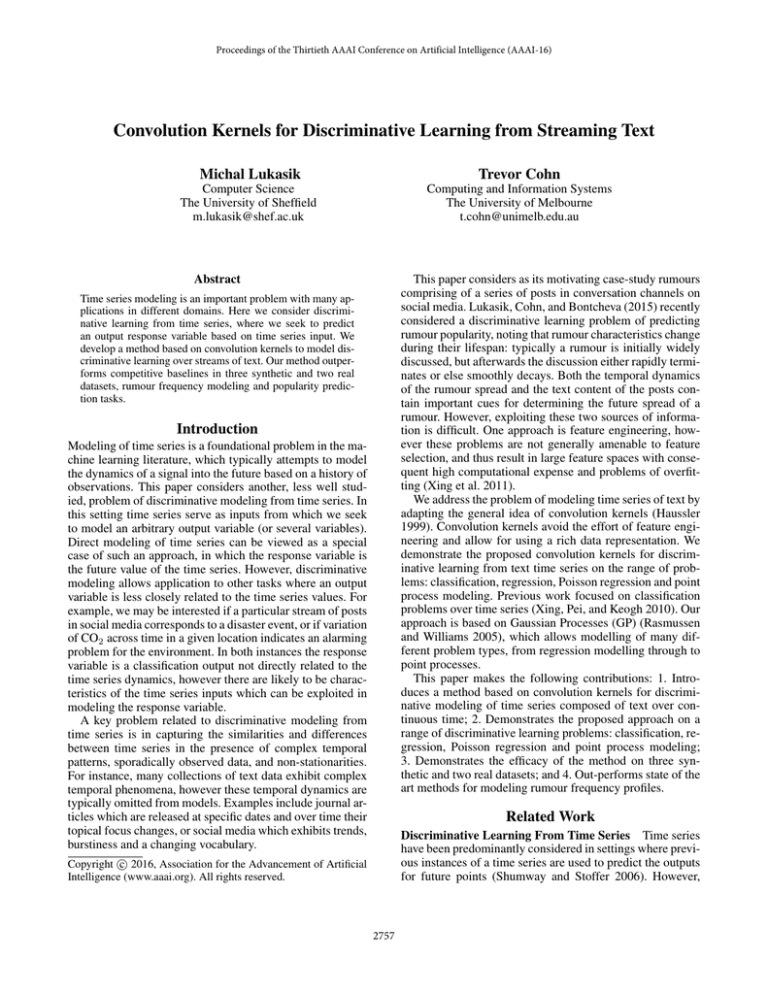
Proceedings of the Thirtieth AAAI Conference on Artificial Intelligence (AAAI-16)
Convolution Kernels for Discriminative Learning from Streaming Text
Michal Lukasik
Trevor Cohn
Computer Science
The University of Sheffield
m.lukasik@shef.ac.uk
Computing and Information Systems
The University of Melbourne
t.cohn@unimelb.edu.au
This paper considers as its motivating case-study rumours
comprising of a series of posts in conversation channels on
social media. Lukasik, Cohn, and Bontcheva (2015) recently
considered a discriminative learning problem of predicting
rumour popularity, noting that rumour characteristics change
during their lifespan: typically a rumour is initially widely
discussed, but afterwards the discussion either rapidly terminates or else smoothly decays. Both the temporal dynamics
of the rumour spread and the text content of the posts contain important cues for determining the future spread of a
rumour. However, exploiting these two sources of information is difficult. One approach is feature engineering, however these problems are not generally amenable to feature
selection, and thus result in large feature spaces with consequent high computational expense and problems of overfitting (Xing et al. 2011).
We address the problem of modeling time series of text by
adapting the general idea of convolution kernels (Haussler
1999). Convolution kernels avoid the effort of feature engineering and allow for using a rich data representation. We
demonstrate the proposed convolution kernels for discriminative learning from text time series on the range of problems: classification, regression, Poisson regression and point
process modeling. Previous work focused on classification
problems over time series (Xing, Pei, and Keogh 2010). Our
approach is based on Gaussian Processes (GP) (Rasmussen
and Williams 2005), which allows modelling of many different problem types, from regression modelling through to
point processes.
This paper makes the following contributions: 1. Introduces a method based on convolution kernels for discriminative modeling of time series composed of text over continuous time; 2. Demonstrates the proposed approach on a
range of discriminative learning problems: classification, regression, Poisson regression and point process modeling;
3. Demonstrates the efficacy of the method on three synthetic and two real datasets; and 4. Out-performs state of the
art methods for modeling rumour frequency profiles.
Abstract
Time series modeling is an important problem with many applications in different domains. Here we consider discriminative learning from time series, where we seek to predict
an output response variable based on time series input. We
develop a method based on convolution kernels to model discriminative learning over streams of text. Our method outperforms competitive baselines in three synthetic and two real
datasets, rumour frequency modeling and popularity prediction tasks.
Introduction
Modeling of time series is a foundational problem in the machine learning literature, which typically attempts to model
the dynamics of a signal into the future based on a history of
observations. This paper considers another, less well studied, problem of discriminative modeling from time series. In
this setting time series serve as inputs from which we seek
to model an arbitrary output variable (or several variables).
Direct modeling of time series can be viewed as a special
case of such an approach, in which the response variable is
the future value of the time series. However, discriminative
modeling allows application to other tasks where an output
variable is less closely related to the time series values. For
example, we may be interested if a particular stream of posts
in social media corresponds to a disaster event, or if variation
of CO2 across time in a given location indicates an alarming
problem for the environment. In both instances the response
variable is a classification output not directly related to the
time series dynamics, however there are likely to be characteristics of the time series inputs which can be exploited in
modeling the response variable.
A key problem related to discriminative modeling from
time series is in capturing the similarities and differences
between time series in the presence of complex temporal
patterns, sporadically observed data, and non-stationarities.
For instance, many collections of text data exhibit complex
temporal phenomena, however these temporal dynamics are
typically omitted from models. Examples include journal articles which are released at specific dates and over time their
topical focus changes, or social media which exhibits trends,
burstiness and a changing vocabulary.
Related Work
Discriminative Learning From Time Series Time series
have been predominantly considered in settings where previous instances of a time series are used to predict the outputs
for future points (Shumway and Stoffer 2006). However,
c 2016, Association for the Advancement of Artificial
Copyright Intelligence (www.aaai.org). All rights reserved.
2757
another strand of research involves discriminative learning
from time series, where the aim is to perform classification
over whole time series data. In general, three classes of approaches have been considered for discriminative learning
from time series: model based, feature based and distance
based methods (Xing, Pei, and Keogh 2010).
Model based approaches specify generative processes for
the classification labels, e.g., using Hidden Markov Models (HMM) (Rabiner 1989), where a sequence of symbols is
modelled as a Markov process with latent states. The HMM
model has been applied for discriminative learning from biological sequences (Xing, Pei, and Keogh 2010). In this approach, an unknown sequence is being assigned a label with
the highest alignment score. This method is not appropriate
in our setting, because we consider time series of complex
objects, namely documents, treated as bags-of-words. Moreover, we consider continuous time, rather than discrete time
as in a typical HMM application.
As for the feature based methods, several approaches have
been proposed. A popular approach is extraction of informative subsequence patterns (shapelets), which has been proposed in conjunction with decision trees (Ye and Keogh
2011) or SVM (Ando and Suzuki 2014). Closely related is
extraction of meta features, the user-defined recurring substructures of a time series (Kadous and Sammut 2005). However, these approaches were not applied in the joint temporal
and textual space. Prior work on discriminative modelling
of temporal text corpora was based on feature engineering,
such as descriptors of temporal pattern of text (Becker, Naaman, and Gravano 2011). Feature engineering may be troublesome and it is difficult to capture all important characteristics in the data. Firstly, the feature selection and extraction
from time series data is not trivial, and secondly the feature space for time series can be high and thus computationally expensive (Xing et al. 2011). In this work we propose a
kernelized approach where no explicit feature extraction is
needed.
Another approach to time series classification is based on
using distance functions for comparing pairs of time series.
The distance function is used in conjunction with a distance
based classification method such as KNN or SVM (Xing,
Pei, and Keogh 2010). In case of simple time series popular
approaches were euclidean distance for time series of equal
lengths and Dynamic time warping (DTW) for sequences of
unequal lengths (Keogh and Pazzani 2000). These kernels
may be appropriate for simple time series, however, they are
not adequate for this work as we deal with complex time
series of text over continuous time.
Another distance based method is kernel fusion scheme
(Wu, Wu, and Chang 2005), in which multiple feature extraction methods are used to produce feature representations,
and modelled with several different kernels. The kernels are
combined together by a weighted sum or other more complex combining function. Similarly, we consider a combination of kernels over text and over time treated as different
representations of time series, which can be viewed as an
instantiation of the kernel fusion scheme.1 However, in our
1
main contribution we do not combine kernels over different
representations of time series, but use R-convolution (Haussler 1999) between kernels over individual points from them,
which is a more powerful method, as we show in experimental sections.
Other examples of kernels used for modeling time series inputs include Fisher kernels (Jaakkola and Haussler
1999), graph edit distance kernels (Bunke and Allermann
1983), the probability product kernel (Jebara, Kondor, and
Howard 2004) and marginalized kernels (Tsuda et al. 2001).
Although designed for time series, none of the above are appropriate for our problem, since we consider multi-variate
time series of text documents occurring in continuous time.
None of these above algorithms were applied to multivariate time series of text. Moreover, they considered only classification settings, whereas we consider more scenarios in
our experiments, such as regression, Poisson regression and
point process modeling problems over time series inputs.
Text Modeling Research on text analysis focuses mainly
on exploiting structure in text only, rarely making use of
time. Discriminative learning over textual time series focused on symbolic sequences, where no timestamp is considered. Dynamic time warping has been applied for comparing text modelled as a time series (Liu, Zhou, and Zheng
2007; Matuschek, Schlüter, and Conrad 2008). Support vector machines with string kernels have been applied for comparing text sequences (Lodhi et al. 2002). In these approaches text is modelled as a discrete sequence, where no
timestamp is assigned to them. Other relevant work includes
classifying social media events (sets of posts occurring in
time), and has been attempted by manual feature engineering, such as descriptors of temporal patterns of text (Becker,
Naaman, and Gravano 2011).
Convolution Kernels Convolution kernels is a framework
in which kernels between structured objects are specified
as a combination of kernel values between substructures
(Haussler 1999). Convolution kernels have been applied to
discrete objects, for example graphs (Vishwanathan et al.
2010). A compelling natural language processing example is
a tree kernel which operates on syntax trees through recursive decomposition into kernels between subtrees (Collins
and Duffy 2001). Of particular relevance are string kernels,
which recursively decompose strings into substrings (Lodhi
et al. 2002). These kernels treat inputs as time series over
discrete time. In this work we design a convolution kernel
tailored to series of text over continuous time.
Notation and Problem Formulation
Let us consider a set of events X = {xi }, each of which
consists of a set of posts xi = {pik }. Posts are tuples
pik = (wki , tik ), where wki is a vector text representation and
tik is a timestamp describing post pik . This way, events are
time series over complex objects. One can imagine different
weighted average, where weights are kernel variances optimized
by maximizing the evidence in the Gaussian Process framework.
Here the different ‘views’ of time series are combined in a
2758
The kernel in equation (2) is expressed as a double summation of kernels between each pair of posts. It can be also
viewed as a convolution kernel between the events, where
the decomposition is made into substructures being posts,
and combined via simple summation. In this paper we use a
linear kernel for the text, although note that we could easily
replace k with another kernel for comparing the text, e.g. a
string kernel or an RBF kernel, in which case this ceases to
be equivalent to a kernel over the concatenated text.
The first non-trivial convolution kernel we consider is the
linear kernel normalized by the event sizes,
1
Ktext (xi , xj ) =
ktext wki , wlj . (3)
|xi ||xj | i
j
situations for which the kernels we introduce can be easily
adapted, e.g. using different text representation by applying
string kernels over the text (Lodhi et al. 2002).
In this work we consider a range of discriminative problems, where time series are inputs and we model an output
variable (most often a numerical value, but may be more
complex as in case of point process below), i.e. the dataset
has form D = {xi , yi }ni=1 . In particular, we consider the
following four general classes of problems:
1. Binary classification, where the task is to model a binary
valued function over events, yi ∈ {0, 1}, e.g. labelling
events as rumours or non-rumours;
2. Regression, where the task is to model a real valued function over events, yi ∈ R, e.g. price of stocks described by
a time series of posts about them;
3. Poisson regression, where the task is to model a nonnegative integer valued function over events, yi ∈ N, e.g.
based on events up to time t, determining the number of
posts in future time interval.
4. Frequency prediction, where the task is to based on the
events embedded in same space, model a non-negative integer valued function over subspaces of this space; e.g.
based on events up to time t, determining the number of
posts in arbitrary future time intervals. In this case, yi
could be a complete set of points over the observation
window.
Our kernel approach is capable of modelling a broader
range of problems than those listed above. For example, it
could be used in a kernelled clustering method for event detection in a social media stream. In this case, we can group
together tweets based on the distance calculated using convolution kernel over text and time.
pk ∈xi pl ∈xj
We normalize the kernel values so that time series of varying
length can be reliably compared without any bias towards
longer structures.
A shortcoming of Ktext is that it operates on text only and
ignores time. Therefore, we introduce a convolution kernel
using time,
1
Ktime (xi , xj ) =
ktime tik , tjl . (4)
|xi ||xj | i
j
pk ∈xi pl ∈xj
This kernel should be useful for comparison of raw time series without additional metadata. For comparing
time values
(t −t )2
2
we use an RBF kernel, ktime (ti , tj ) = σ2 exp − i l j ,
where σ22 is a hyper-parameter controlling the output scale,
while l > 0 is the length scale, determining the rate at which
the kernel diminishes with distance.
We also consider a summation of time and text kernels,
Convolution Time Series Kernels
Ktext+time (xi , xj ) = Ktext (xi , xj ) + Ktime (xi , xj ).
In this section we describe the central contribution of the
paper - convolution kernels between time series of posts described by text over continuous time.
Note that kernel text+time can be viewed as an instantiation of the kernel fusion scheme (Wu, Wu, and Chang
2005) where different views of time series are combined in
a weighted average, where weights are kernel variances.
The final convolution kernel we consider compares pairs
of posts via a product of kernels over text and time,
Formulations
A kernel over events can be formulated in many different
ways. Probably the most obvious is concatenating text from
posts together and comparing resulting texts across events,
e.g. using a kernel on the vectors. Such kernel can be expressed via the formula
⎛
⎞
j
wki ,
wl ⎠ . (1)
KΣtext (xi , xj ) = ktext ⎝
pik ∈xi
(5)
Ktext◦time (xi , xj ) =
1
|xi ||xj |
ktext wki , wlj ktime tik , tjl .(6)
pik ∈xi pjl ∈xj
This way, the kernel captures not only the textual similarities between posts coming from the two time series, but also
how close they are in time. It effectively weights influence
coming from each pair of posts by how far apart in time they
were created. In this way it can focus on differences in the
usage of text across time.
In the Supplementary Materials2 we provide a proof, that
those kernels correspond to R-convolutions, which themselves are valid kernels (Haussler 1999).
pjl ∈xj
Note that we denote kernels over events with capital K and
kernels over their component posts using small k.
A very popular kernel choice for text is the linear kernel,
which takes the form ktext (w1 , w2 ) = σ12 w1 w2 where σ12
is a learned scaling hyper-parameter. Combined with equation (1), the kernel simplifies to
(2)
ktext wki , wlj .
KΣtext (xi , xj ) =
2
The Supplementary Materials can be accessed
http://people.eng.unimelb.edu.au/tcohn/papers/aaai2016.pdf.
pik ∈xi pjl ∈xj
2759
at
Gaussian Processes
Inference
In this section we describe the probabilistic framework of
Gaussian Processes (GPs), which we use to demonstrate the
usefulness of our kernels. GPs support application to a range
of problems, e.g. Poisson regression, allow for learning the
hyperparameter values (σ1 , σ2 , l) without expensive crossvalidation, and also explicitly model predictive uncertainty.
In case of non Gaussian likelihoods, the posterior is intractable and approximation techniques are required. There
exist various methods to deal with calculating the posterior. For classification we use Expectation Propagation (EP;
(Minka and Lafferty 2002)). In EP, the posterior is approximated by a fully factorised distribution, where each component is assumed to be an unnormalized Gaussian. The
parameters of the approximation are iteratively refined to
minimise Kullback-Leibler divergence between the true posterior and the approximation. For Poisson regression and
LGCP we use Laplace approximation, which approximates
the posterior by a Gaussian distribution based on the first two
moments of the posterior. Both EP and Laplace approximations yield a Gaussian distribution, making the computations
of the posterior over f tractable.
The Framework
GPs are a Bayesian non-parametric framework that has been
shown to work well for a range of problems, often beating other state-of-the-art methods (Cohn and Specia 2013;
Beck, Cohn, and Specia 2014). They are widely used for regression, however can also be used for other modeling problems including classification and Poisson regression. The
central concept of a GP is a latent function f over inputs
x: f (x) ∼ GP(m(x), k(x, x )), where m is the mean function, assumed to be 0 and k is the kernel, specifying the degree to which the outputs covary as a function of the inputs.
Let X denote the training set of inputs, y be the corresponding set of training outputs, x∗ be the test input and f∗
be the corresponding latent function value. The GP posterior
is obtained using the prior and the likelihood p(y|f ),
p(f |y) =
p(y|f )p(f )
,
p(y|X)
Hyperparameter Learning
A standard approach to learning hyperparameters in the
Gaussian Processes framework is by finding the Type II
Maximum Likelihood Estimate on the training set via coordinate descent. This requires finding gradients of the kerdK(xi ,xj )
, where
nel with respect to the hyperparameters
dθ
2
2
θ = (σ1 , σ2 , l) or a subset thereof, depending on the choice
of kernel. Each time series kernel is a double summation
over pairs of posts, which makes the gradients straightforward to compute.
(7)
where in case of regression p(y|f ) is a Gaussian distribution,
and it can be used to compute the predictive distribution of
latent function values at test data points as
(8)
p(f ∗ |X, y, x∗ ) = p(f ∗ |X, x∗ , f )p(f |y)df .
Experiments on Synthetic Data
We introduce a synthetic experimental setting where we
generate events with different temporal, textual and joint
temporal-textual characteristics. Our aim is to generate data
which is difficult to model using only time or text, but
to model the data well requires incorporation of information about text occurrences over time. Below we introduce
the generative process we use to simulate the inputs for
events x1 , . . . , xn (in the Supplementary Materials we provide more detailed information).
Each event xi is generated as a collection of posts, where
each post timestamp is drawn iid from a Beta distribution,
tik ∼ Beta(αi , βi ), and the text component is generated
by drawing each word index from a Geometric distribui
tion, wkl
∼ Geom ci1 + (ci2 − ci1 )tik , from which a bag-ofwords vector representation is computed for each document
wki . The hyperparameters αi , βi , ci1 , ci2 differ across events
xi , albeit only slightly, which is achieved by drawing their
values from a global prior. The difficulty of discriminative
modeling from the events comes from small differences between the generative processes governing them.
We couple the generated events with response variables in
three different ways.
Non Gaussian Likelihoods
For classification, the latent function is mapped by the
squashing function Φ(f ) (in our case probit) into the range
[0, 1], such that the result can be interpreted as p(y = 1|x).
For Poisson
nregression, the likelihood of outputs is given
as p(y|f ) = j=1 Poisson (yj | exp(fj )), the Poisson likelihood where the parameter is drawn from the GP, using exponentiation to enforce positivity. The posterior allows us
to answer several interesting questions, such as what is the
most probable output count for input x∗ .
Log-Gaussian Cox Process
Poisson regression allows modeling of a single count variable. However, one may be interested in modeling counts
of events in arbitrary subspaces of an input space, e.g. to
answer a question like how many tweets arrived in an interval of time in Twitter. A popular method used for point
data is a Poisson process, which assumes that the number of
events occurring
in an interval [s, e] is Poisson distributed
e
with rate s λ(t)dt. A log-Gaussian Cox process (LGCP)
(Møller and Syversveen 1998) is an example of a Poisson
process, where the intensity function λ(t) is modelled such
that log λ(t) ∼ GP(0,
an approxima e k(t, t )). We assume
tion of an integral s λ(t)dt ≈ (e − s)λ( e+s
2 ), which allows
training the LGCP by applying the Poisson likelihood within
the Gaussian Process framework.
Regression: the response variable for event xi is set to yi =
ci1 −ci2 . We use a data set of 100 events with 20 posts each,
and evaluate using mean squared error (MSE).
Classification: each event is assigned a binary label yi ∈
{−, +}, and the text generating hyperparameters are tied
for events with the same label, i.e., cia = cα
a where yi = α,
2760
classification
(ACC↑)
synthetic data
regression
Poisson regression
(MSE↓)
(LL↑)
Ottawa+Ferguson
classification
(ACC↑)
mean
majority
0.44 ± 0.04
0.16 ± 0.08
-
-39.15 ± 8.18
-
0.701 ± 0.021
text
time
text+time
0.62 ± 0.16
0.44 ± 0.04
0.57 ± 0.12
0.15 ± 0.08
0.15 ± 0.07
0.14 ± 0.07
-39.46 ± 9.42
-39.40 ± 8.21
-37.01 ± 8.66
0.678 ± 0.025
0.740 ± 0.015
0.738 ± 0.011
text ◦ time
0.80 ± 0.16
0.05 ± 0.03
-31.00 ± 5.63
0.748 ± 0.009
Table 1: Results from the synthetic and rumour data experiments for a range of methods (mean ± std dev), showing classification
accuracy, mean squared error for regression and Poisson log likelihood. In case of synthetic experiments, we ran 55 experiments
of each setting, taking 80% of events for training and 20% for testing. In case of the rumour classification experiment, the results
are averaged using five-fold cross validation.
for α ∈ {−, +}, a ∈ {1, 2}. For each label we generate
1000 posts, split into 50 events, and evaluate using predictive accuracy.
Poisson regression: similar to regression, each event has
different word generating parameters,
and the response
variable is set to yi = max 1, 1 + 10(ci1 − ci2 ) . We
generate 100 events of 20 posts each and evaluate using
the log likelihood (LL) under a Poisson likelihood with
parameter equal to predicted mean.
Figure 1: Comparison of accuracy between convolution kernels, showing performance of kernels text ◦ time (blue circles) and text (green crosses) in the synthetic experiments.
The plot shows the accuracy as the parameter q controlling
the differences across text distributions varies, thus changing
the amount of signal in text.
In the three leftmost columns of Table 1 we report results
from the three experiment settings. In all settings, text ◦ time
yields excellent results, outperforming the other methods. In
contrast, the simpler kernels (text, time, text+time) did not
significantly improve over the mean or majority baseline.
This is because baseline kernels, and most importantly the
fusion kernel text+time, do not capture the differences between how the word distributions change over time, an important characteristic of events in our synthetic data.
In Figure 1 we analyze how the performance of the convolution kernels changes as the parameter q controlling the difference of text distributions across events changes (q is the
variance of noise perturbing the parameters ci1 , ci2 from the
common mean; see Supplementary Materials for more information about this parameter). Notice that as text marginally
differs more across events – due to high variance in appropriate component of generative process – the kernels using text or time only become more and more effective. We
observed similar phenomenon when varying the temporal
noise term (r), and comparing with the performance of other
baseline kernels, i.e., time and text ◦ time. Therefore, the
text ◦ time kernel is particularly useful when the differences
across events can be found in the temporal variations of text,
and are not particularly strong in text or time alone.
Data
We conduct experiments on two social media datasets. The
first dataset consists of 114 popular rumours collected in August 2014 during the Ferguson unrest and is composed of
4098 tweets. This dataset has been used by Lukasik, Cohn,
and Bontcheva (2015) for rumour dynamics modeling. We
will show how the introduced convolution kernels outperform the state of the art approaches from their work.
We also consider a second dataset consisting of tweets
collected October 2014 during Ottawa shootings and in August 2014 during the Ferguson unrest (Zubiaga et al. 2015).
The corpus consists of 288 Ferguson rumours and 470 Ottawa rumours, and is composed of 13,002 tweets.
For both datasets, in order to reduce feature sparsity, we
replace words with their Brown cluster ids. We used 1000
clusters acquired on a large Twitter corpus (Owoputi et
al. 2013), following Lukasik, Cohn, and Bontcheva (2015),
whose method we use for benchmarking our results.
Rumour Modeling with Point Processes
Experiments on Social Media Data
The first task is rumour dynamics modeling, introduced by
Lukasik, Cohn, and Bontcheva (2015). Consider a set of rumours {xi }, in which each rumour is represented by a set
of posts xi = {pik }. The problem is as follows: given the
We now consider evaluation of our approach on two social
media datasets. The two tasks we consider are related to rumour popularity modeling.
2761
MSE
LL
HPP
GP regression
Interpolate
0
LGCP
LGCP ICM
LGCP TXT
LGCP ICM+TXT
7.14±10.1
4.58±11.0
4.90±13.1
2.76±7.81
3.44±9.99
2.46±7.82
2.32±7.06
2.31±7.80
-23.5±10.1
-34.6±8.78
-15.8±11.6
-14.8±11.2
-14.7±9.12
-14.6±10.8
LGCP text ◦ time
2.22±7.12
-14.2±8.7
Figure 2: Error analysis versus event lengths (counts of posts
in their first hour) for the rumour classification experiment.
Showing the probability of error for all events of that length
using the GP with the text ◦ time kernel.
Table 2: MSE between the true counts and the predicted
counts (lower is better) and predictive log likelihood of
the true counts from probabilistic models (higher is better)
for test intervals over the 114 Ferguson rumours, showing
mean ± std. dev. All except the final result are taken from
(Lukasik, Cohn, and Bontcheva 2015).
Rumour Classification
come popular. Here we use the rumour dataset consisting of
470 Ottawa and 288 Ferguson rumours. As with the earlier
rumour dataset, we consider a set of rumours and based on
the first hour of posts from rumour xi , the task is to predict
if the number of posts in the second hour equals or exceeds
a threshold τ . This results in a binary classification problem,
in which we predict which rumours are likely to become or
remain popular. For most events we observe a rapid decrease
in the counts of posts over time: the mean of number of posts
in the first hour is 11.08, and only 1.91 in the second hour.
For this reason we set the threshold to τ = 2, which results
in around 30% of events being labelled as positive instances.
We model the data using supervised GP classification, and
evaluate the predictive accuracy with 5-fold cross validation,
reporting our results in the rightmost column of Table 1. The
best accuracy is achieved for the kernel text ◦ time, achieving the score of 0.748. Although this is a small improvement
over the mean prediction from the time kernel, notice that
the results were much more robust than the other methods
(text ◦ time kernel has by far the lowest standard deviation).
Overall this is a very difficult modeling problem, although
our methods were able to improve over the majority baseline with the best method providing a relative error reduction of 16%. We also notice, that kernel text+time performs
worse than text ◦ time, reinforcing our statements from synthetic experiments section that it is a less powerful method
in capturing the dynamics of multivariate time series.
Next, we inspect how errors vary across event lengths
for the text ◦ time kernel. In Figure 2 we plot points corresponding to events of appropriate size and probability of
being assigned a wrong class according to the GP output.
Note that there are consistently more events correctly versus incorrectly classified across all event sizes. Even though
there is a group of wrongly predicted events of small sizes
(upper-left part), there are many more small events that are
correctly classified (lower-left part). Surprisingly even short
events are overall predicted well, which is a big achievement
due to the fact that little data is available for them. On close
inspection we found that the text ◦ time kernel shows the
greatest improvements over time kernel for shorter events,
where presumably text brings much needed information.
The second problem is about predicting whether a rumour
will be popular, framed as classification. This case study is
applicable when authorities or journalists wish to track social media, e.g. for identifying rumours that are going to be-
In this work we introduced convolution kernels for discriminative modeling from continuous time series of text. We
first hour of posts from a rumour xi , predict the counts of
tweets in each of the 6-minutes intervals from the second
hour. The predictions are evaluated using two metrics: mean
squared error (MSE) over each test interval, and the predictive log-likelihood (LL), used for probabilistic approaches
only. Evaluation is run in a leave one out manner, where the
prediction is made for each rumour, using the first hour of
tweets from the rumour as well as (depending on a method)
full two hours of tweets for the remaining 113 rumours.
We reproduce several baselines from (Lukasik, Cohn, and
Bontcheva 2015): Homogenous Poisson Process (denoted
HPP), Gaussian Process regression (GP), Interpolation and
a ‘predict no tweets’ method (0), all of which are single
task methods. The state of the art benchmark methods are
based on log-Gaussian Cox Processes. The first approach
uses an RBF kernel to independently model each target rumour (denoted LGCP). The remaining methods use multitask learning over the collections of rumours, using an RBF
kernel across time intervals combined in a product with a rumour kernel. The rumour kernel uses the rumour text (TXT)
and/or explicit learning of a low-rank matrix of rumour correlations (ICM). For more information about these methods,
we refer the reader to (Lukasik, Cohn, and Bontcheva 2015).
We report the results on the 114 Ferguson rumours in
Table 2, the same dataset as originally used by Lukasik,
Cohn, and Bontcheva (2015). The previous state of the art
model was LGCP ICM+TXT and is outperformed by LGCP
text ◦ time under both evaluation criteria. Notice how for
both metrics the predictive variance is equal to or smaller
than the best benchmark results. Thus LGCP text ◦ time not
only outperforms the previous best method, but also yields
more robust predictions.
Conclusions
2762
Liu, X.; Zhou, Y.; and Zheng, R. 2007. Sentence similarity
based on dynamic time warping. In ICSC, 250–256.
Lodhi, H.; Saunders, C.; Shawe-Taylor, J.; Cristianini, N.;
and Watkins, C. 2002. Text classification using string kernels. J. Mach. Learn. Res. 2:419–444.
Lukasik, M.; Cohn, T.; and Bontcheva, K. 2015. Point process modelling of rumour dynamics in social media. In Proc.
of the 53rd ACL, vol. 2, 518–523.
Matuschek, M.; Schlüter, T.; and Conrad, S. 2008. Measuring text similarity with dynamic time warping. In Proc. of
the 2008 IDEAS, 263–267.
Minka, T., and Lafferty, J. 2002. Expectation-propagation
for the generative aspect model. In Proc. of the 18th UAI,
352–359.
Møller, J., and Syversveen, A. R. 1998. Log Gaussian Cox
processes. Scandinavian Journal of Statistics 451–482.
Owoputi, O.; Dyer, C.; Gimpel, K.; Schneider, N.; and
Smith, N. A. 2013. Improved part-of-speech tagging for
online conversational text with word clusters. In Proc. of
NAACL, 380–390.
Rabiner, L. R. 1989. A tutorial on hidden markov models
and selected applications in speech recognition. In Proc. of
the IEEE, 257–286.
Rasmussen, C. E., and Williams, C. K. I. 2005. Gaussian Processes for Machine Learning (Adaptive Computation and Machine Learning). The MIT Press.
Shumway, R. H., and Stoffer, D. S. 2006. Time Series Analysis and Its Applications: With R Examples (Springer Texts
in Statistics). Springer, 2nd edition.
The GPy authors. 2015. GPy: A Gaussian process framework in Python. http://github.com/SheffieldML/GPy.
Tsuda, K.; Kawanabe, M.; Rtsch, G.; Sonnenburg, S.; and
Mller, K.-R. 2001. A new discriminative kernel from probabilistic models. In Proc. of NIPS, 977–984.
Vishwanathan, S. V. N.; Schraudolph, N. N.; Kondor, R.; and
Borgwardt, K. M. 2010. Graph kernels. J. Mach. Learn. Res.
11:1201–1242.
Wu, Y.; Wu, G.; and Chang, E. Y.
2005.
Multiview sequence-data representation and non-metric distancefunction learning.
Xing, Z.; Pei, J.; Yu, P. S.; and Wang, K. 2011. Extracting
interpretable features for early classification on time series.
In SDM, 247–258.
Xing, Z.; Pei, J.; and Keogh, E. 2010. A brief survey on
sequence classification. SIGKDD Explor. Newsl. 12(1):40–
48.
Ye, L., and Keogh, E. 2011. Time series shapelets: a novel
technique that allows accurate, interpretable and fast classification. Data Mining and Knowledge Discovery 22(12):149–182.
Zubiaga, A.; Liakata, M.; Procter, R.; Bontcheva, K.; and
Tolmie, P. 2015. Towards detecting rumours in social media.
In AAAI Workshop on AI for Cities, 380–390.
evaluated the kernels on synthetic data, where we demonstrated intuitive examples where one can expect the kernels
to perform well. We also evaluated the kernels on two rumour popularity modeling problems, namely rumour modeling via point processes and rumour popularity classification, and showed how time series convolution kernels outperform the strong baselines. Our proposed convolution kernel can be used in many other potential applications involving discriminative modelling over textual time series, such
as activity prediction of social media users or event detection in Twitter.
Acknowledgments
We would like to thank Zsolt Bitvai, Srijith P.K., Daniel
Beck and Tomasz Kusmierczyk for helpful discussions and
the anonymous reviewers for useful comments. The work
was partially supported by the European Union under grant
agreement No. 611233 P HEME, and the Australian Research Council Future Fellowship scheme (project number
FT130101105). The work was implemented using the GPy
toolkit (The GPy authors 2015).
References
Ando, S., and Suzuki, E. 2014. Discriminative learning on
exemplary patterns of sequential numerical data. In ICDM,
1–10.
Beck, D.; Cohn, T.; and Specia, L. 2014. Joint emotion analysis via multi-task gaussian processes. In Proc. of EMNLP,
1798–1803.
Becker, H.; Naaman, M.; and Gravano, L. 2011. Beyond
trending topics: Real-world event identification on Twitter.
In ICWSM.
Bunke, H., and Allermann, G. 1983. Inexact graph matching for structural pattern recognition. Pattern Recogn. Lett.
1(4):245–253.
Cohn, T., and Specia, L. 2013. Modelling annotator bias
with multi-task gaussian processes: An application to machine translation quality estimation. In Proc. of the 51st
ACL, vol. 1, 32–42.
Collins, M., and Duffy, N. 2001. Convolution kernels for
natural language. In Proc. of NIPS, 625–632.
Haussler, D. 1999. Convolution kernels on discrete structures. Technical Report UCS-CRL-99-10, University of California at Santa Cruz.
Jaakkola, T. S., and Haussler, D. 1999. Exploiting generative
models in discriminative classifiers. In Proc. of NIPS, 487–
493.
Jebara, T.; Kondor, R.; and Howard, A. 2004. Probability
product kernels. J. Mach. Learn. Res. 5:819–844.
Kadous, M. W., and Sammut, C. 2005. Classification of
multivariate time series and structured data using constructive induction. Mach. Learn. 58(2-3):179–216.
Keogh, E. J., and Pazzani, M. J. 2000. Scaling up dynamic
time warping for datamining applications. In Proc. of 6th
KDD, 285–289.
2763


